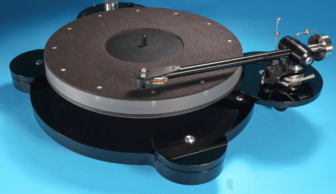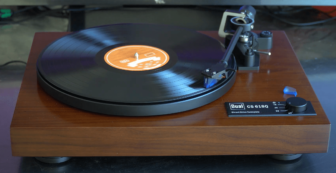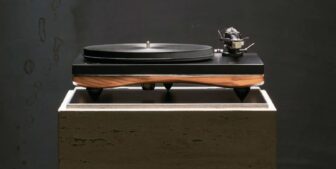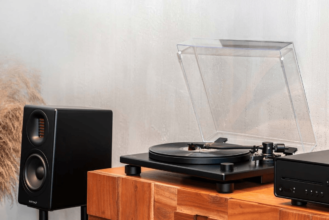Acoustic Signature Verona NEO Review
Solid, comprehensible technology without voodoo. Logical solutions. Solid as a rock. Quick and easy to adjust. Impressive scope of delivery including high-quality tool sets. No more questions, Your Honor.
by Roland Kraft
Contents
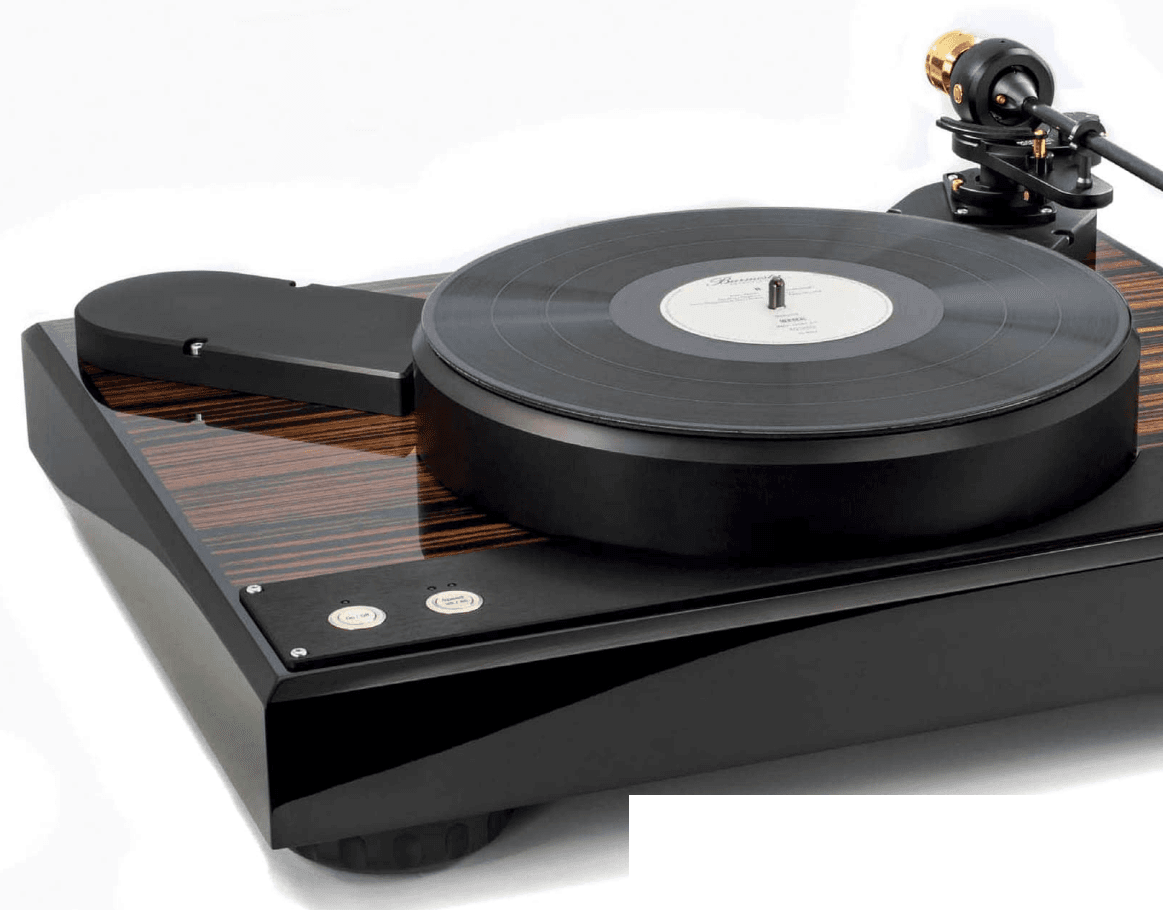
Test & Technology
Turntable without Cartridge
Let’s share a little insider info. Anyone who has been testing turntables of all kinds and from all over the world for decades gathers not only experiences but also insights. And sometimes prejudices. Naturally, as with all products, it’s also about price and performance, calculation, material and personnel costs, know-how, fashion trends, and customer desires.
And it’s, it’s simply undeniable, also about (technical) ideology, sometimes stubborn designers, about dead ends or, much worse, about designs that are solely there to impress onlookers. Meaning: Not all chrome- and gold-laden metal mountains make technical or even sonic sense, and not every cheap turntable stripped down to a barely functional wooden board with a motor does what it’s supposed to upon closer listening. Unforgettable are the philosophies like the weak motor (spin-up time of two minutes), the string drive (0.05-millimeter nylon thread, four meters long), or tonearms mounted in creep-prone silicone that adjust their tracking error angle themselves as a function of room temperature. And when you then think you’ve seen it all, an audio-enthused social worker lets a 10-kilogram platter rotate with an axle thinner than a pencil. Oh, sorry. We’ll now switch back from irony to the mildness of old age.
It’s Different
This admittedly long introduction brings us now to a turntable where (attention, words of praise!) simply everything is right. The concept. The construction. The execution. The equipment. And of course, the sound. It’s about the Acoustic Signature Verona Neo plus the tonearm TA-2000 Neo from the same company. The Verona Neo is first of all big, very big, namely 54 by 45 centimeters. A literally broad base. With a low center of gravity. And something like this doesn’t wobble, to put it simply. Especially not when “it” weighs 33 kilograms. And stands on three feet. Not on four, mind you. Turntables with four feet are wrong, as you realize at the latest during leveling, which is accomplished in a few seconds with the large, easily rotatable, but rock-solid and gel-damped feet of the Verona. And these feet are even so high that you can comfortably get your fingers under the chassis, a highly practical thing that is unfortunately very rarely found. Adjustable feet for which you have to lift the entire turntable are also wrong.
The sheer size of the Verona allows the mounting of up to two 12-inch tonearms on massive aluminum plates that are intimately screwed to the heavy plinth. The latter follows the sandwich construction usual at Acoustic Signature of MDF, steel, and multiplex, and is more than six centimeters thick. That something still resonates here is extremely unlikely. And that also applies to the hidden drive of the belt-driven turntable.
“Silencers” in the 11-Kilogram Platter
But let’s stay first with the most important visible part of this turntable, namely its mighty platter. It alone weighs 11 kilograms and also comes with a technology that is common at Acoustic Signature: Pressed-in brass cylinders, called Silencer modules, eight in number, safely drive out even the last vibrations from the shiny, 50-millimeter-high aluminum disc. This ensemble is complemented by two additional damping mats. One sits on the underside of the platter, the second simply serves as a platter mat. This already very heavy platter rests in turn once again in a precisely fitting sub-platter, whose upper part protrudes from a round cover plate in the plinth. Underneath hides the secret of this turntable: a speed-controlled double-belt drive with two AC motors.
Two Motors? Yes.
Bearings are usually plain bearings with a very thin film of lubricant in the bearing bush. It stands to reason that one-sided tensile load due to a drive belt is not optimal under the aspect of longevity. Especially when a powerful drive is supposed to “pull” a heavy platter and a certain belt tension is indispensable. The solution from Acoustic Signature’s chief Gunther Frohnhöfer is a double drive: two opposing motors, two drive belts. The pressure load on the bearing bush averages out in the optimal case. And by relocating the drive train into the closed “basement” of the plinth, dust and UV light, which are harmful to the rubber belts, have no chance anymore. The expected objection that two motors also mean double unrest in the drive train is justified. Various effects can occur here up to mutually amplifying cogging of both motors. The motors here are constructed with two coils and 24 poles each.
Acoustic Signature solves such problems with a very elaborate motor control with digital monitoring, which detects “distortions” in the drive in real-time and makes appropriate corrections. They named this technology “Automatic Vibration Control” (Automatic Vibration Control), and it is used in the turntables in three possible expansion stages, which ultimately culminates in three AVC-synchronized motors in the top models. In terms of sound, we should also say a few words about the technology used here; the never-ending discussion about direct and belt drive has been going on for decades and polarizes between the energetic, perhaps tighter and more “authoritative” direct drive sound and the one described as more sensitive, calmer, and more differentiated belt drive.
Possibly, a “tight”, fairly strong belt drive with short belts around a much smaller diameter sub-platter (instead of around the platter) is a wonderful compromise or even the best of both worlds? For us, the sound of the Verona Neo certainly points in exactly this direction, so that one may attest this drive concept to be simply spot-on.
Consideration of another “critical point” in turntables, the bearing, should not be missing. Especially today’s commonly used heavy platters cause enormous surface pressure between the bearing mirror and ball in conventional bearing technology, which is, in terms of longevity, also a problem zone like the noise development of the bearing, which emanates from precisely this point. (Whether heavy record weights, also called stabilizers, are right or wrong? You decide now.)
The problem solver in our test turntable is called DTD (Duraturn Diamond Bearing) and refers to an axis that achieves extreme hardness through plasma coating, as well as bearing bushes that can store significantly more oil than usual sintered metal. Acoustic Signature remains silent about the bottom of the bearing but confidently gives a full 15-year warranty. By the way, one can indeed imagine the smooth running of a turntable like the residual noise of an amplifier: What disappears into it is also not audible. The “black” background of the sound image determines how high the achievable dynamics are, with turntables also, from experience, determining how cleanly very low tones are defined. With absolute top turntables like the Verona Neo, there is deepest, “blackest” silence; the running noise of the needle in the groove dominates, whereby sharper needle cuts like that of our mounted Hana Umami Blue indeed extract more information but also “run louder”.
9- and 12-Inch Tonearm
With the TA-2000 Neo, Acoustic Signature contributes not a feature-laden marvel but a solid, easily adjustable tonearm that is available in 9 and 12-inch versions, poses no riddles, and should get along with practically any cartridge. The packaging includes not only the necessary tools but also an adjustment template that simultaneously serves as a mounting jig. This makes setting the mounting distance (distance between pivot point and platter axis) a breeze via the SME-standard arm base.
To this end, the tonearm offers a small hole on the round top of its cardanic bearing, which is to be aligned with its pointed counterpart on the adjustment template. It doesn’t get any easier, especially since the offset angle is finally adjusted via the central fastening screw at the front of the carbon tube. Anyone who isn’t doing this for the first time is actually done in a good quarter of an hour. Again, everything done right, the adjuster rejoices, who should have an electronic tonearm scale and can rely on the smooth precision ball bearings providing completely play-free guidance. The arm height is adjusted via a clamping screw on the steel shaft, which you should sensibly do before the tracking geometry. The straightforward and beautifully crafted arm also offers an azimuth adjustment for those who believe in it, and finally, there is even an included 1.5-meter phono cable from AudioQuest. Analog heart, what more do you want? A height-adjustable lift and an armrest with a proper securing clamp. It has that too. Again, everything done right.
Silence is Stronger than Storm
This time, we’ll follow along a single record for the listening recommendation, which says everything you want to know about this (or other) turntables. If you’re in the mood to go on a vinyl hunt: KIJC 9125, The Super Analogue Disc, Adagio D’Albinoni / Gary Karr, Harmon Lewis. A Japanese recording from 1981, which presses both the tear ducts and the pedals of a mighty organ. Not only audiophile but really good music, which literally exploits the foundation and now serves as the basis of an already stunningly high-caliber performance: pressure, volume, definition, depth—playback at a level that makes any discussion superfluous.
The typical authority of a super turntable, but also its finesse. The moments of silence on the extraordinary record are equally expressive: Silence means the absence of noise. And you can take that literally here. Rock-solid spatial representation adds to it; the sound image is enormously wide, exemplary detached, but also tangible-present and not just simply set back. The Umami Blue convinces on this proverbial basis just as much as the TA-2000, which seems anything but overstrained and is wide open for experiments in terms of cartridges. And the sonic certainty that is fundamentally constructively present in this turntable and not the result of hours of adjustment orgies, manifold experiments, or a particularly fancy base, suggests that there is even room for improvement.
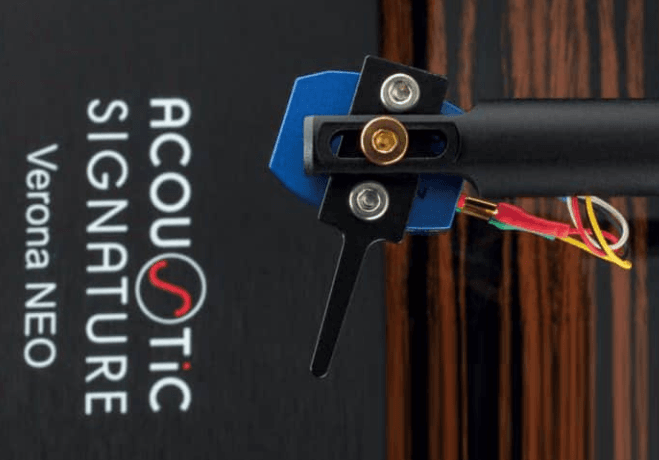
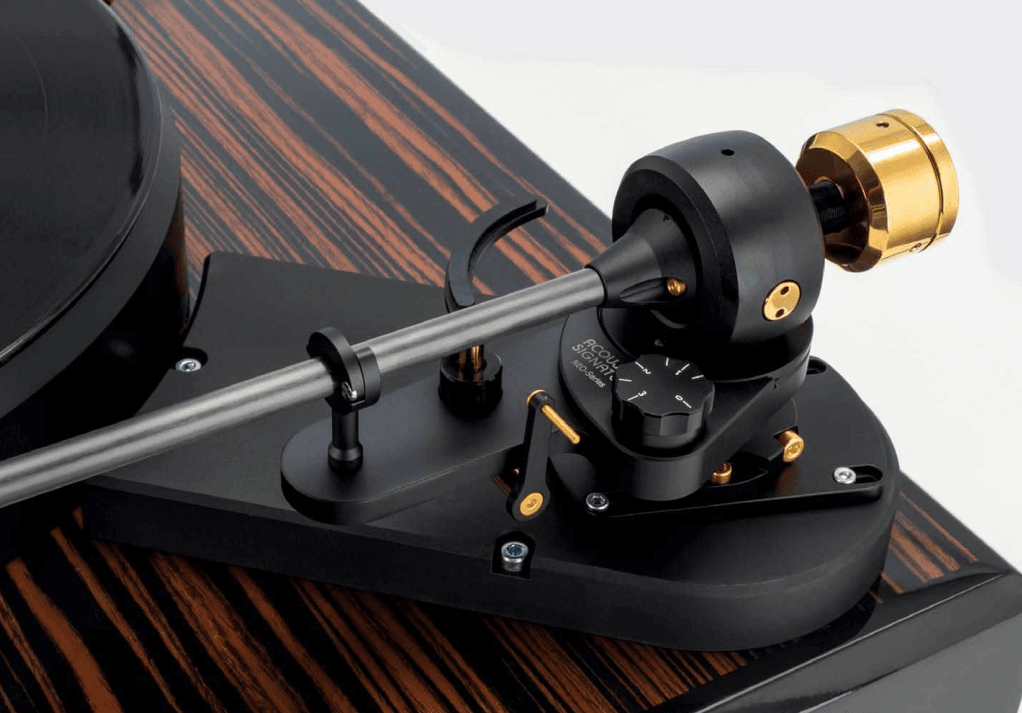
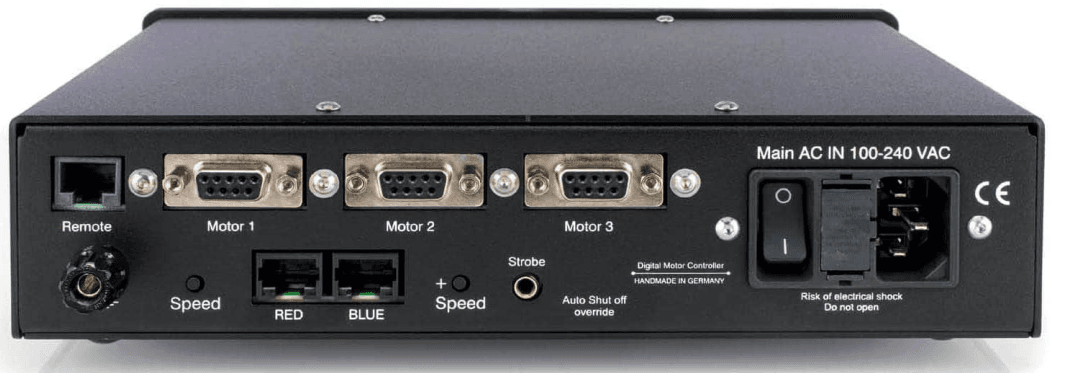

Acoustic Signature Verona NEO Report
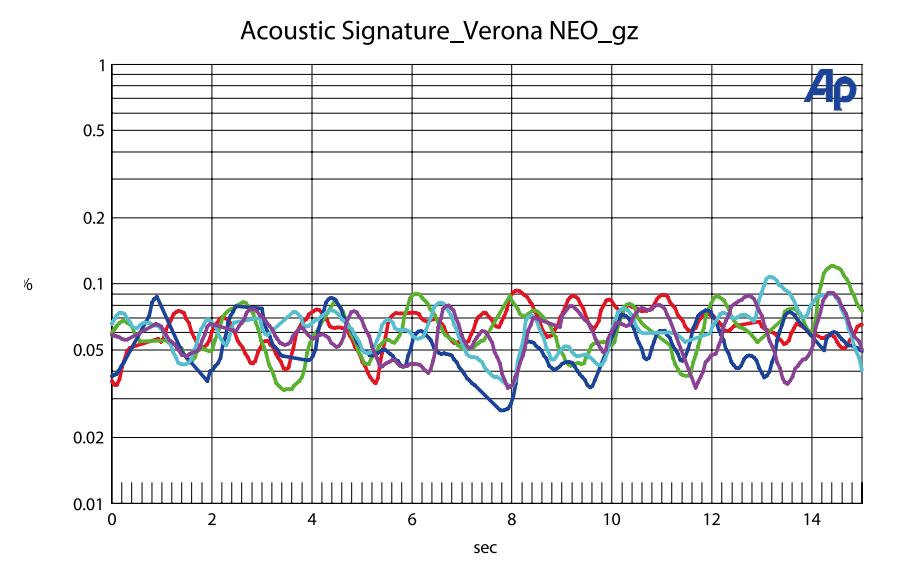
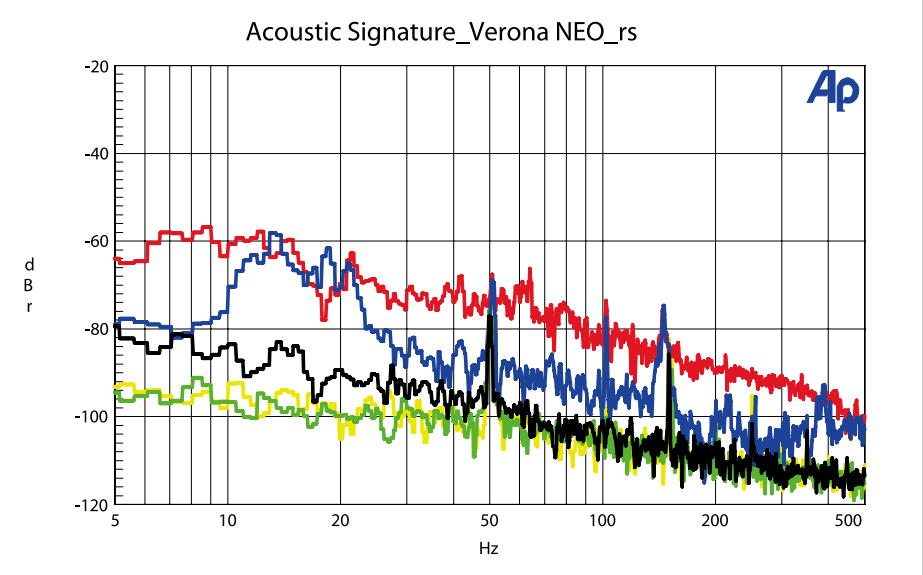
The gz-diagram shows the pitch deviation over time (wow and flutter) evaluated according to IEC 386. Shown are the five best samples out of 20 runs. After averaging over the 2-sigma scatter interval, the turntable achieves above-average 0.09%. The absolute speed can even be set perfectly in tune. The second diagram informs about rumble noise of the turntable: Mains hum at 50, 100, and 150 Hz is detectable only with a measurement coupler (blue), the former already disappears in the inherent noise of the record (red). Evaluated signal-to-noise ratio 72/76 dB (record/measurement coupler).
Specs
Product: Acoustic Signature – Verona NEO/TA‑2000
- List Price: €12,000 + €3,350
- Warranty Period: 15 years
- Dimensions (W × H × D): 54.4 cm × 16.6 cm × 44.9 cm
- Weight: 33 kg
- Drive System: Belt
- Speeds: 33 & 45 rpm
- Speed Switching: ● (electronic)
- Tonearm Height Adjustment: ●
- Height‑Adjustable Feet: ●
- Pitch Control: –
- Fully Automatic/End‑of‑Record Shutoff: – / –
- Special Features: Two motors
CONCLUSION:
Compliments. Even if the pleasure has its price. Remains the question: Do you need more turntables? Crystal clear: no. A second tonearm? Why not …
PRO & CONTRA
Pros
- Sound quality beyond dispute (exceptionally good)
- Superb craftsmanship
- Accommodates up to two tonearms (up to 12″ in length)
Con
- High investment
TEST RESULTS
- Sound (Cinch / XLR): 178 points
- (Approx. 9.9 / 10 on a notional 180‑point maximum)
- Features: Very good
- Ease of Use: Very good
- Build Quality: Outstanding
7Review BENCHMARK
- Overall Verdict: 178 points
- (Approx. 9.9 / 10 on a notional 180‑point maximum)
- Price/Performance: Outstanding



